Comprehensive Report: Financial Analysis of HSBC Banking Operations
VerifiedAdded on 2022/11/30
|10
|2493
|285
Report
AI Summary
This report provides an in-depth analysis of financial management principles, specifically applied to HSBC, a multinational financial institution. It begins with an introduction to business finance and the importance of financial management, including its role in planning, forecasting, and financial reporting. The report then delves into the key components of financial statements, including the income statement, balance sheet, and cash flow statement, explaining their significance in assessing a company's financial position and performance. The use of financial ratios in evaluating profitability, liquidity, and efficiency is also discussed. The report includes a Business Review Template analyzing ratios like gross profit ratio, net profit ratio, shareholder equity, current ratio, and quick ratio. The analysis covers HSBC's financial performance, highlighting profitability, liquidity, and efficiency. Finally, the report suggests ways to improve financial performance, such as consolidating debt and recovering outstanding payments, concluding that financial management is crucial for business growth and profitability. The report leverages financial records and ratio analysis to inform decision-making and enhance competition.

Applied Business Finance
Paraphrase This Document
Need a fresh take? Get an instant paraphrase of this document with our AI Paraphraser
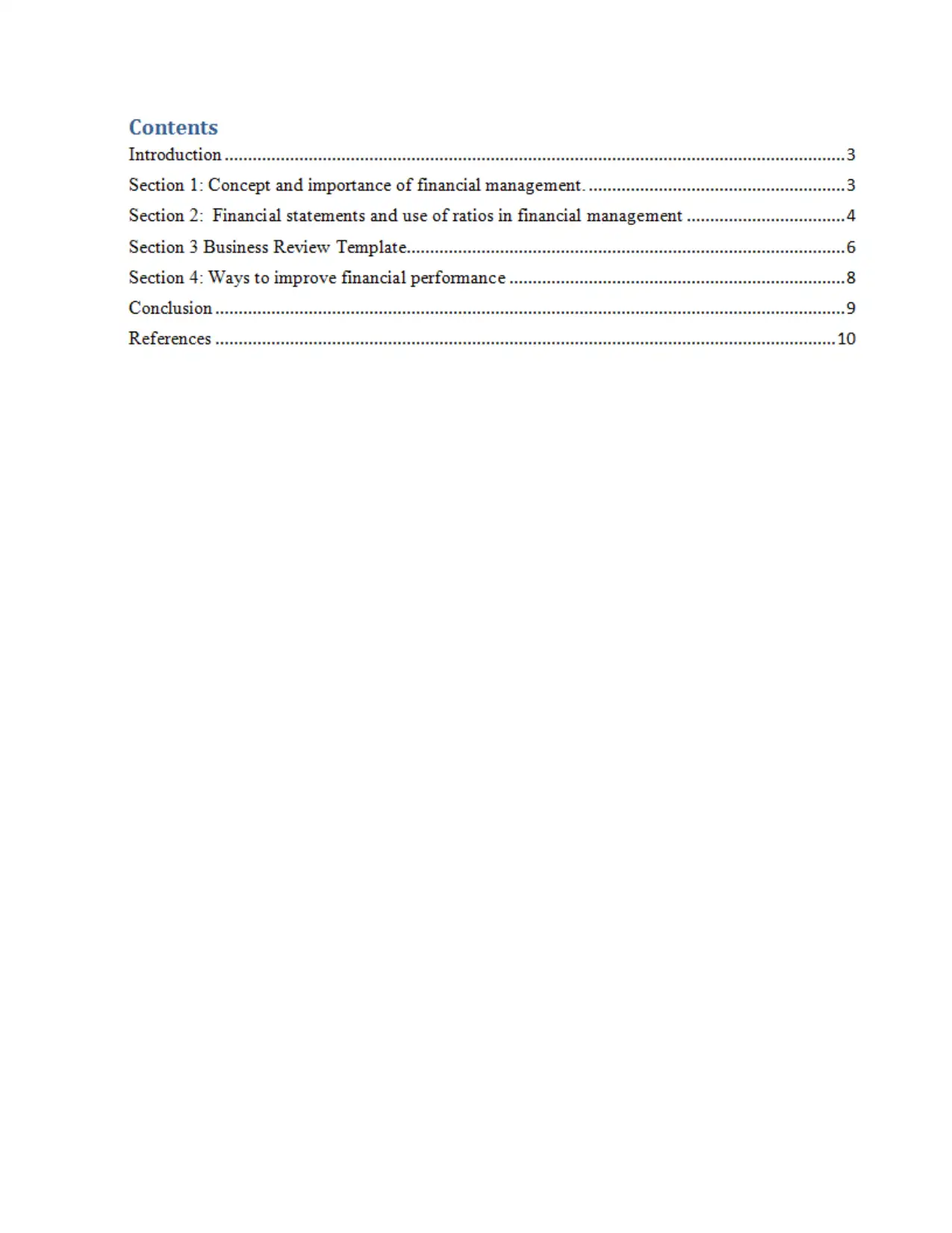
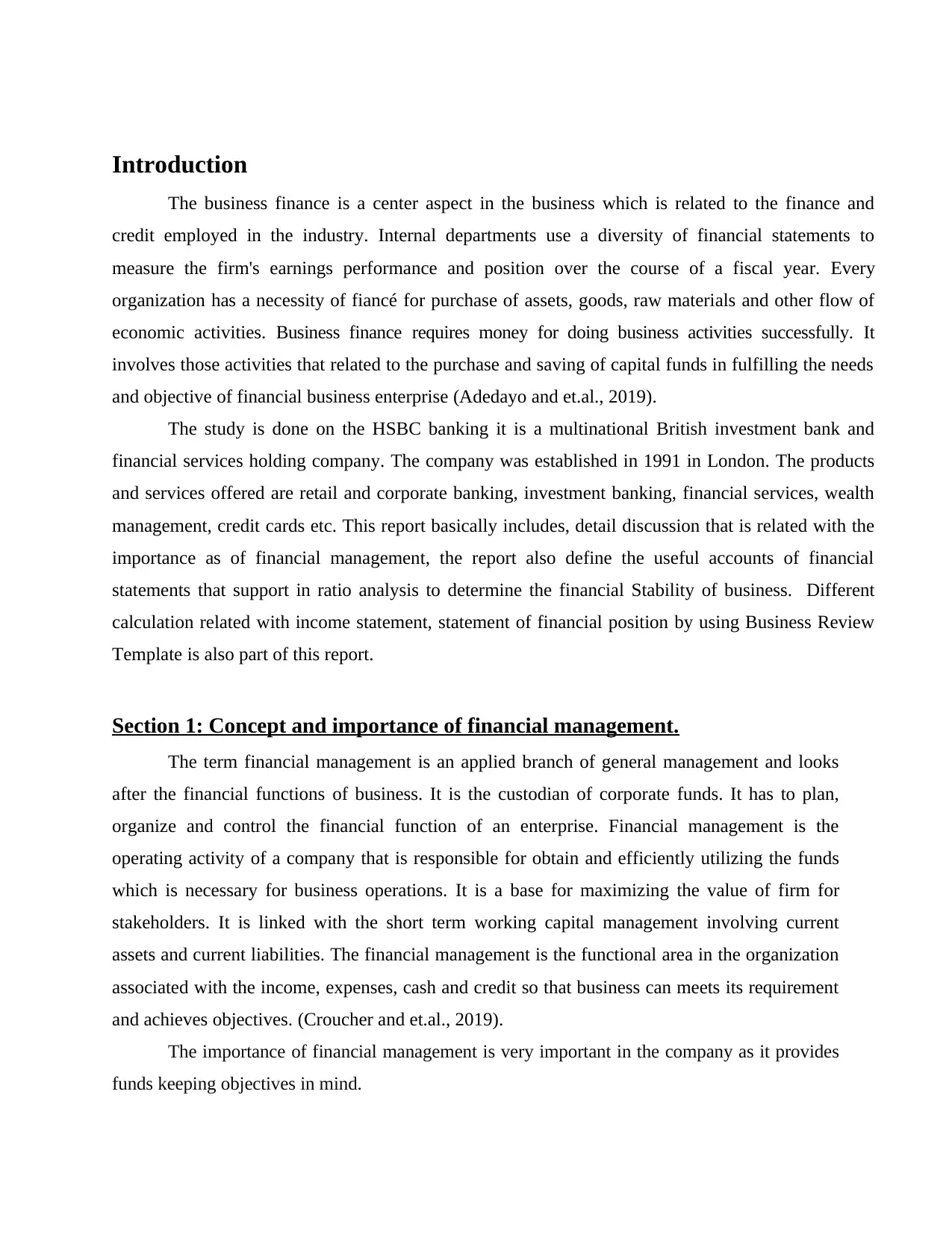
Introduction
The business finance is a center aspect in the business which is related to the finance and
credit employed in the industry. Internal departments use a diversity of financial statements to
measure the firm's earnings performance and position over the course of a fiscal year. Every
organization has a necessity of fiancé for purchase of assets, goods, raw materials and other flow of
economic activities. Business finance requires money for doing business activities successfully. It
involves those activities that related to the purchase and saving of capital funds in fulfilling the needs
and objective of financial business enterprise (Adedayo and et.al., 2019).
The study is done on the HSBC banking it is a multinational British investment bank and
financial services holding company. The company was established in 1991 in London. The products
and services offered are retail and corporate banking, investment banking, financial services, wealth
management, credit cards etc. This report basically includes, detail discussion that is related with the
importance as of financial management, the report also define the useful accounts of financial
statements that support in ratio analysis to determine the financial Stability of business. Different
calculation related with income statement, statement of financial position by using Business Review
Template is also part of this report.
Section 1: Concept and importance of financial management.
The term financial management is an applied branch of general management and looks
after the financial functions of business. It is the custodian of corporate funds. It has to plan,
organize and control the financial function of an enterprise. Financial management is the
operating activity of a company that is responsible for obtain and efficiently utilizing the funds
which is necessary for business operations. It is a base for maximizing the value of firm for
stakeholders. It is linked with the short term working capital management involving current
assets and current liabilities. The financial management is the functional area in the organization
associated with the income, expenses, cash and credit so that business can meets its requirement
and achieves objectives. (Croucher and et.al., 2019).
The importance of financial management is very important in the company as it provides
funds keeping objectives in mind.
The business finance is a center aspect in the business which is related to the finance and
credit employed in the industry. Internal departments use a diversity of financial statements to
measure the firm's earnings performance and position over the course of a fiscal year. Every
organization has a necessity of fiancé for purchase of assets, goods, raw materials and other flow of
economic activities. Business finance requires money for doing business activities successfully. It
involves those activities that related to the purchase and saving of capital funds in fulfilling the needs
and objective of financial business enterprise (Adedayo and et.al., 2019).
The study is done on the HSBC banking it is a multinational British investment bank and
financial services holding company. The company was established in 1991 in London. The products
and services offered are retail and corporate banking, investment banking, financial services, wealth
management, credit cards etc. This report basically includes, detail discussion that is related with the
importance as of financial management, the report also define the useful accounts of financial
statements that support in ratio analysis to determine the financial Stability of business. Different
calculation related with income statement, statement of financial position by using Business Review
Template is also part of this report.
Section 1: Concept and importance of financial management.
The term financial management is an applied branch of general management and looks
after the financial functions of business. It is the custodian of corporate funds. It has to plan,
organize and control the financial function of an enterprise. Financial management is the
operating activity of a company that is responsible for obtain and efficiently utilizing the funds
which is necessary for business operations. It is a base for maximizing the value of firm for
stakeholders. It is linked with the short term working capital management involving current
assets and current liabilities. The financial management is the functional area in the organization
associated with the income, expenses, cash and credit so that business can meets its requirement
and achieves objectives. (Croucher and et.al., 2019).
The importance of financial management is very important in the company as it provides
funds keeping objectives in mind.
⊘ This is a preview!⊘
Do you want full access?
Subscribe today to unlock all pages.

Trusted by 1+ million students worldwide
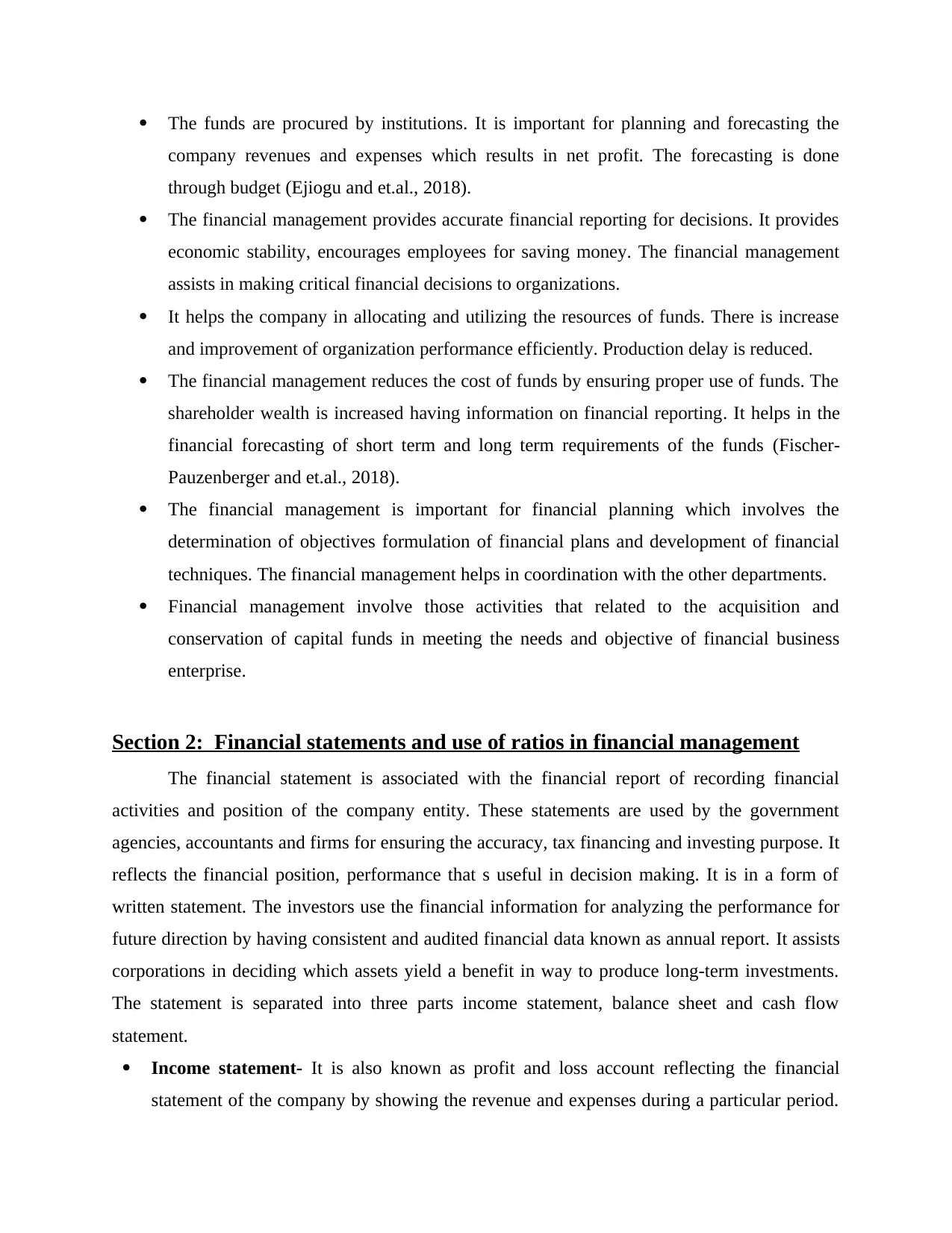
The funds are procured by institutions. It is important for planning and forecasting the
company revenues and expenses which results in net profit. The forecasting is done
through budget (Ejiogu and et.al., 2018).
The financial management provides accurate financial reporting for decisions. It provides
economic stability, encourages employees for saving money. The financial management
assists in making critical financial decisions to organizations.
It helps the company in allocating and utilizing the resources of funds. There is increase
and improvement of organization performance efficiently. Production delay is reduced.
The financial management reduces the cost of funds by ensuring proper use of funds. The
shareholder wealth is increased having information on financial reporting. It helps in the
financial forecasting of short term and long term requirements of the funds (Fischer-
Pauzenberger and et.al., 2018).
The financial management is important for financial planning which involves the
determination of objectives formulation of financial plans and development of financial
techniques. The financial management helps in coordination with the other departments.
Financial management involve those activities that related to the acquisition and
conservation of capital funds in meeting the needs and objective of financial business
enterprise.
Section 2: Financial statements and use of ratios in financial management
The financial statement is associated with the financial report of recording financial
activities and position of the company entity. These statements are used by the government
agencies, accountants and firms for ensuring the accuracy, tax financing and investing purpose. It
reflects the financial position, performance that s useful in decision making. It is in a form of
written statement. The investors use the financial information for analyzing the performance for
future direction by having consistent and audited financial data known as annual report. It assists
corporations in deciding which assets yield a benefit in way to produce long-term investments.
The statement is separated into three parts income statement, balance sheet and cash flow
statement.
Income statement- It is also known as profit and loss account reflecting the financial
statement of the company by showing the revenue and expenses during a particular period.
company revenues and expenses which results in net profit. The forecasting is done
through budget (Ejiogu and et.al., 2018).
The financial management provides accurate financial reporting for decisions. It provides
economic stability, encourages employees for saving money. The financial management
assists in making critical financial decisions to organizations.
It helps the company in allocating and utilizing the resources of funds. There is increase
and improvement of organization performance efficiently. Production delay is reduced.
The financial management reduces the cost of funds by ensuring proper use of funds. The
shareholder wealth is increased having information on financial reporting. It helps in the
financial forecasting of short term and long term requirements of the funds (Fischer-
Pauzenberger and et.al., 2018).
The financial management is important for financial planning which involves the
determination of objectives formulation of financial plans and development of financial
techniques. The financial management helps in coordination with the other departments.
Financial management involve those activities that related to the acquisition and
conservation of capital funds in meeting the needs and objective of financial business
enterprise.
Section 2: Financial statements and use of ratios in financial management
The financial statement is associated with the financial report of recording financial
activities and position of the company entity. These statements are used by the government
agencies, accountants and firms for ensuring the accuracy, tax financing and investing purpose. It
reflects the financial position, performance that s useful in decision making. It is in a form of
written statement. The investors use the financial information for analyzing the performance for
future direction by having consistent and audited financial data known as annual report. It assists
corporations in deciding which assets yield a benefit in way to produce long-term investments.
The statement is separated into three parts income statement, balance sheet and cash flow
statement.
Income statement- It is also known as profit and loss account reflecting the financial
statement of the company by showing the revenue and expenses during a particular period.
Paraphrase This Document
Need a fresh take? Get an instant paraphrase of this document with our AI Paraphraser
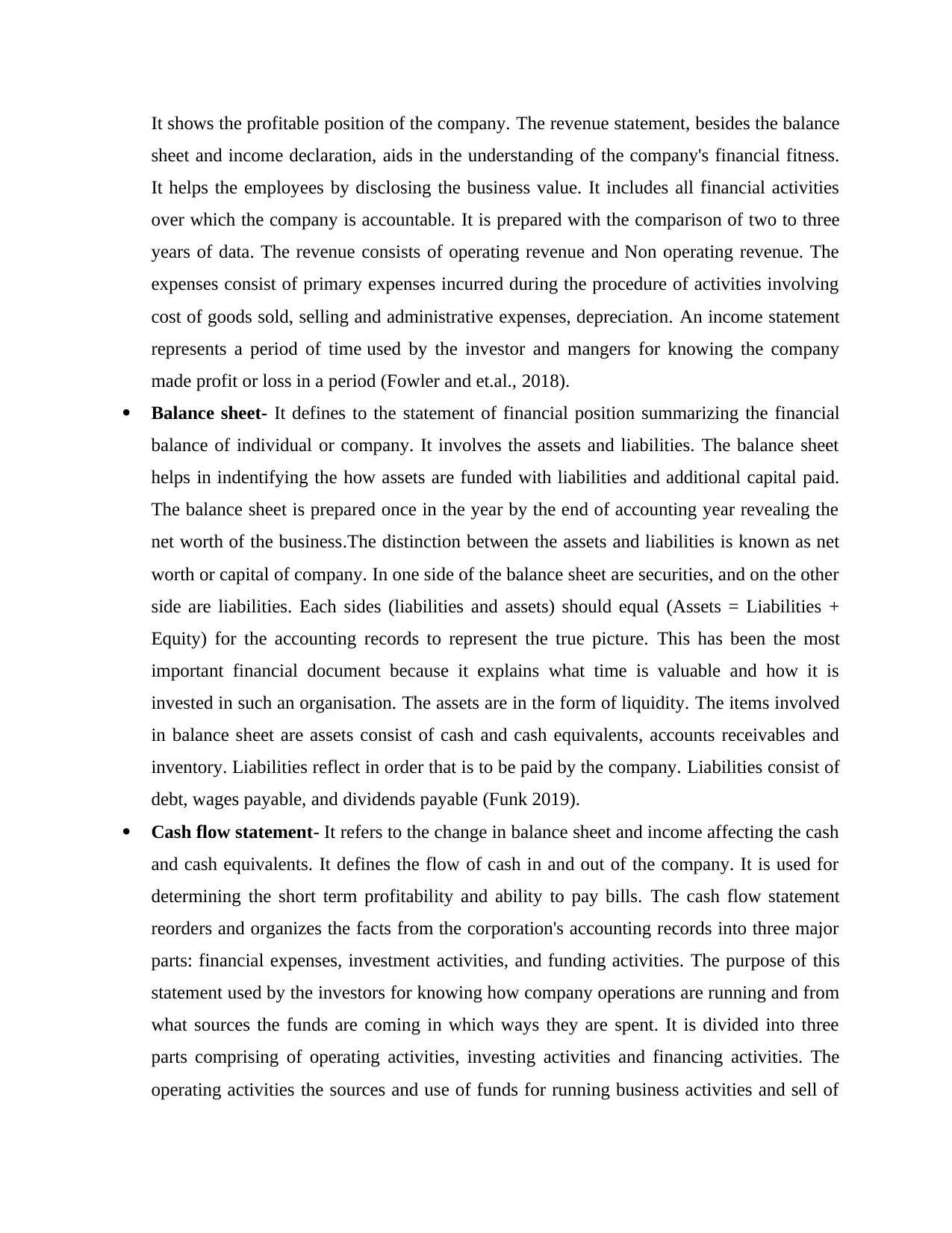
It shows the profitable position of the company. The revenue statement, besides the balance
sheet and income declaration, aids in the understanding of the company's financial fitness.
It helps the employees by disclosing the business value. It includes all financial activities
over which the company is accountable. It is prepared with the comparison of two to three
years of data. The revenue consists of operating revenue and Non operating revenue. The
expenses consist of primary expenses incurred during the procedure of activities involving
cost of goods sold, selling and administrative expenses, depreciation. An income statement
represents a period of time used by the investor and mangers for knowing the company
made profit or loss in a period (Fowler and et.al., 2018).
Balance sheet- It defines to the statement of financial position summarizing the financial
balance of individual or company. It involves the assets and liabilities. The balance sheet
helps in indentifying the how assets are funded with liabilities and additional capital paid.
The balance sheet is prepared once in the year by the end of accounting year revealing the
net worth of the business.The distinction between the assets and liabilities is known as net
worth or capital of company. In one side of the balance sheet are securities, and on the other
side are liabilities. Each sides (liabilities and assets) should equal (Assets = Liabilities +
Equity) for the accounting records to represent the true picture. This has been the most
important financial document because it explains what time is valuable and how it is
invested in such an organisation. The assets are in the form of liquidity. The items involved
in balance sheet are assets consist of cash and cash equivalents, accounts receivables and
inventory. Liabilities reflect in order that is to be paid by the company. Liabilities consist of
debt, wages payable, and dividends payable (Funk 2019).
Cash flow statement- It refers to the change in balance sheet and income affecting the cash
and cash equivalents. It defines the flow of cash in and out of the company. It is used for
determining the short term profitability and ability to pay bills. The cash flow statement
reorders and organizes the facts from the corporation's accounting records into three major
parts: financial expenses, investment activities, and funding activities. The purpose of this
statement used by the investors for knowing how company operations are running and from
what sources the funds are coming in which ways they are spent. It is divided into three
parts comprising of operating activities, investing activities and financing activities. The
operating activities the sources and use of funds for running business activities and sell of
sheet and income declaration, aids in the understanding of the company's financial fitness.
It helps the employees by disclosing the business value. It includes all financial activities
over which the company is accountable. It is prepared with the comparison of two to three
years of data. The revenue consists of operating revenue and Non operating revenue. The
expenses consist of primary expenses incurred during the procedure of activities involving
cost of goods sold, selling and administrative expenses, depreciation. An income statement
represents a period of time used by the investor and mangers for knowing the company
made profit or loss in a period (Fowler and et.al., 2018).
Balance sheet- It defines to the statement of financial position summarizing the financial
balance of individual or company. It involves the assets and liabilities. The balance sheet
helps in indentifying the how assets are funded with liabilities and additional capital paid.
The balance sheet is prepared once in the year by the end of accounting year revealing the
net worth of the business.The distinction between the assets and liabilities is known as net
worth or capital of company. In one side of the balance sheet are securities, and on the other
side are liabilities. Each sides (liabilities and assets) should equal (Assets = Liabilities +
Equity) for the accounting records to represent the true picture. This has been the most
important financial document because it explains what time is valuable and how it is
invested in such an organisation. The assets are in the form of liquidity. The items involved
in balance sheet are assets consist of cash and cash equivalents, accounts receivables and
inventory. Liabilities reflect in order that is to be paid by the company. Liabilities consist of
debt, wages payable, and dividends payable (Funk 2019).
Cash flow statement- It refers to the change in balance sheet and income affecting the cash
and cash equivalents. It defines the flow of cash in and out of the company. It is used for
determining the short term profitability and ability to pay bills. The cash flow statement
reorders and organizes the facts from the corporation's accounting records into three major
parts: financial expenses, investment activities, and funding activities. The purpose of this
statement used by the investors for knowing how company operations are running and from
what sources the funds are coming in which ways they are spent. It is divided into three
parts comprising of operating activities, investing activities and financing activities. The
operating activities the sources and use of funds for running business activities and sell of
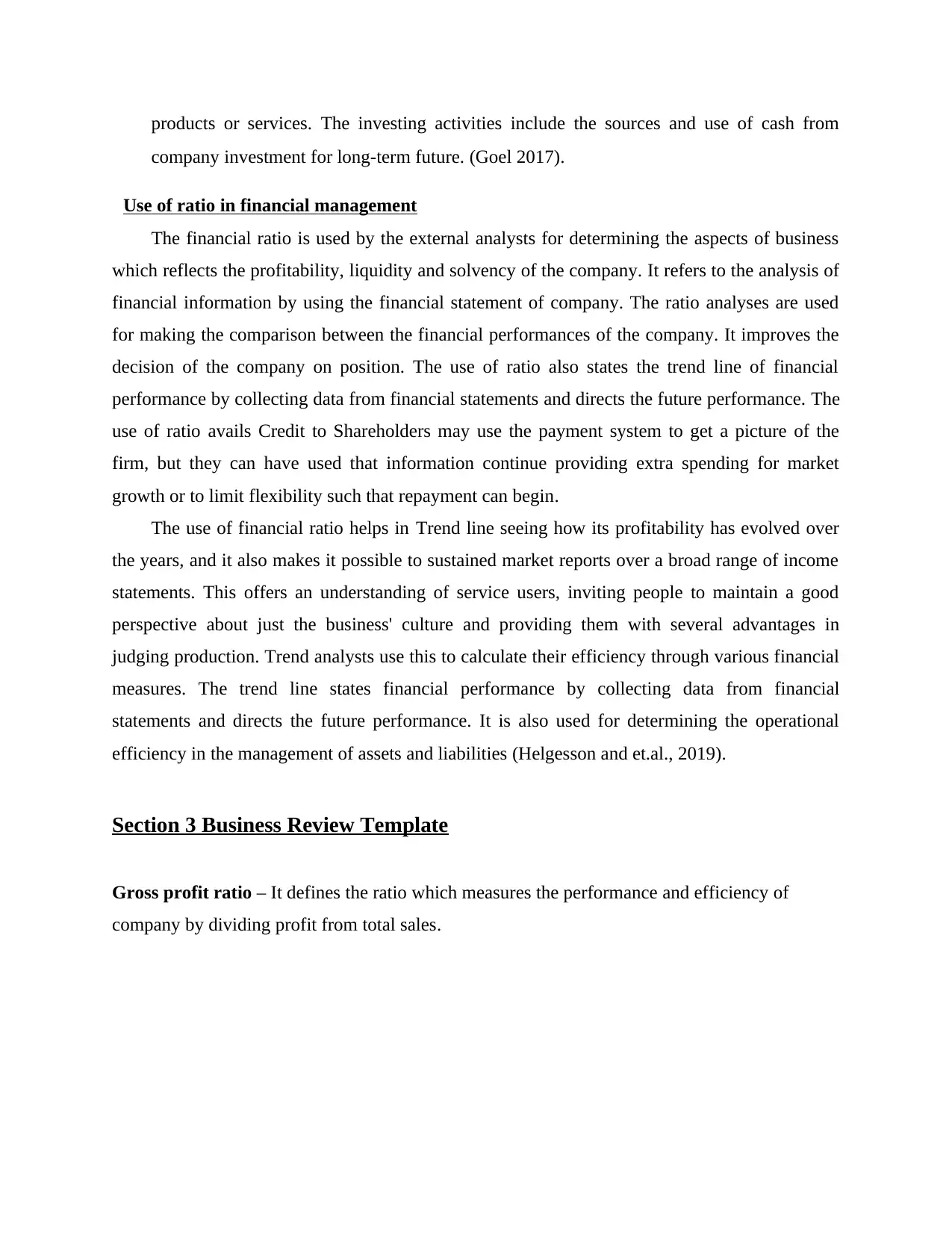
products or services. The investing activities include the sources and use of cash from
company investment for long-term future. (Goel 2017).
Use of ratio in financial management
The financial ratio is used by the external analysts for determining the aspects of business
which reflects the profitability, liquidity and solvency of the company. It refers to the analysis of
financial information by using the financial statement of company. The ratio analyses are used
for making the comparison between the financial performances of the company. It improves the
decision of the company on position. The use of ratio also states the trend line of financial
performance by collecting data from financial statements and directs the future performance. The
use of ratio avails Credit to Shareholders may use the payment system to get a picture of the
firm, but they can have used that information continue providing extra spending for market
growth or to limit flexibility such that repayment can begin.
The use of financial ratio helps in Trend line seeing how its profitability has evolved over
the years, and it also makes it possible to sustained market reports over a broad range of income
statements. This offers an understanding of service users, inviting people to maintain a good
perspective about just the business' culture and providing them with several advantages in
judging production. Trend analysts use this to calculate their efficiency through various financial
measures. The trend line states financial performance by collecting data from financial
statements and directs the future performance. It is also used for determining the operational
efficiency in the management of assets and liabilities (Helgesson and et.al., 2019).
Section 3 Business Review Template
Gross profit ratio – It defines the ratio which measures the performance and efficiency of
company by dividing profit from total sales.
company investment for long-term future. (Goel 2017).
Use of ratio in financial management
The financial ratio is used by the external analysts for determining the aspects of business
which reflects the profitability, liquidity and solvency of the company. It refers to the analysis of
financial information by using the financial statement of company. The ratio analyses are used
for making the comparison between the financial performances of the company. It improves the
decision of the company on position. The use of ratio also states the trend line of financial
performance by collecting data from financial statements and directs the future performance. The
use of ratio avails Credit to Shareholders may use the payment system to get a picture of the
firm, but they can have used that information continue providing extra spending for market
growth or to limit flexibility such that repayment can begin.
The use of financial ratio helps in Trend line seeing how its profitability has evolved over
the years, and it also makes it possible to sustained market reports over a broad range of income
statements. This offers an understanding of service users, inviting people to maintain a good
perspective about just the business' culture and providing them with several advantages in
judging production. Trend analysts use this to calculate their efficiency through various financial
measures. The trend line states financial performance by collecting data from financial
statements and directs the future performance. It is also used for determining the operational
efficiency in the management of assets and liabilities (Helgesson and et.al., 2019).
Section 3 Business Review Template
Gross profit ratio – It defines the ratio which measures the performance and efficiency of
company by dividing profit from total sales.
⊘ This is a preview!⊘
Do you want full access?
Subscribe today to unlock all pages.

Trusted by 1+ million students worldwide
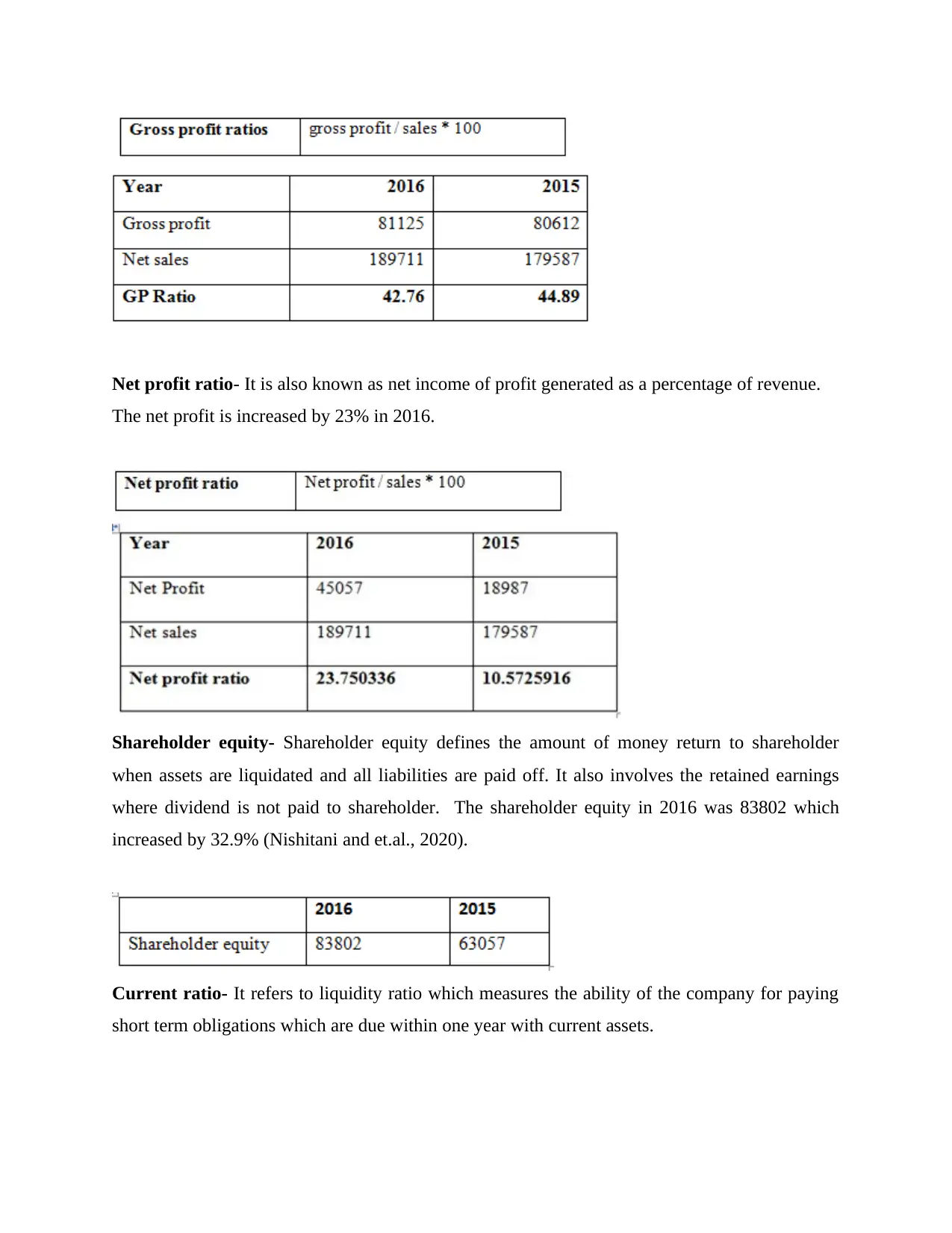
Net profit ratio- It is also known as net income of profit generated as a percentage of revenue.
The net profit is increased by 23% in 2016.
Shareholder equity- Shareholder equity defines the amount of money return to shareholder
when assets are liquidated and all liabilities are paid off. It also involves the retained earnings
where dividend is not paid to shareholder. The shareholder equity in 2016 was 83802 which
increased by 32.9% (Nishitani and et.al., 2020).
Current ratio- It refers to liquidity ratio which measures the ability of the company for paying
short term obligations which are due within one year with current assets.
The net profit is increased by 23% in 2016.
Shareholder equity- Shareholder equity defines the amount of money return to shareholder
when assets are liquidated and all liabilities are paid off. It also involves the retained earnings
where dividend is not paid to shareholder. The shareholder equity in 2016 was 83802 which
increased by 32.9% (Nishitani and et.al., 2020).
Current ratio- It refers to liquidity ratio which measures the ability of the company for paying
short term obligations which are due within one year with current assets.
Paraphrase This Document
Need a fresh take? Get an instant paraphrase of this document with our AI Paraphraser
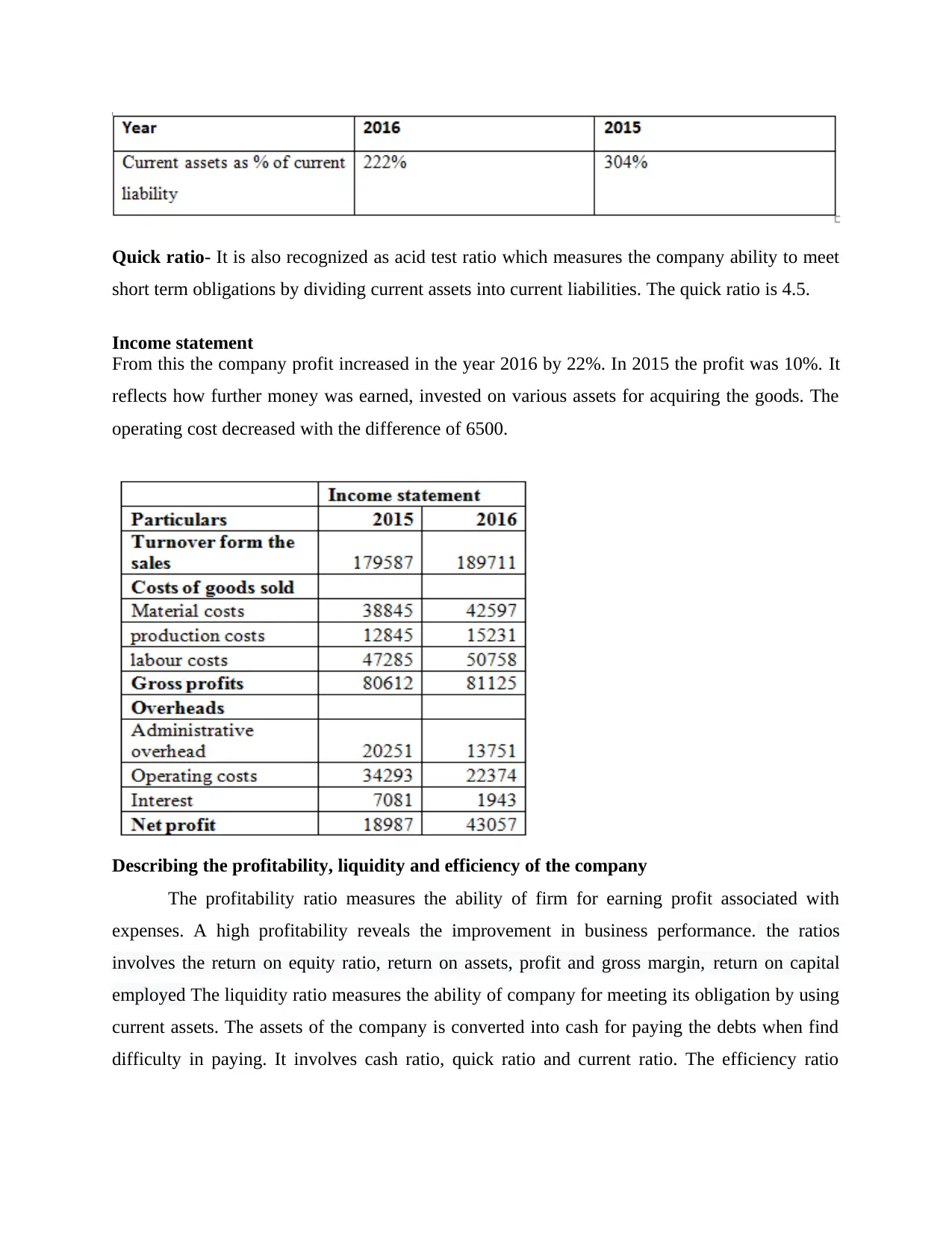
Quick ratio- It is also recognized as acid test ratio which measures the company ability to meet
short term obligations by dividing current assets into current liabilities. The quick ratio is 4.5.
Income statement
From this the company profit increased in the year 2016 by 22%. In 2015 the profit was 10%. It
reflects how further money was earned, invested on various assets for acquiring the goods. The
operating cost decreased with the difference of 6500.
Describing the profitability, liquidity and efficiency of the company
The profitability ratio measures the ability of firm for earning profit associated with
expenses. A high profitability reveals the improvement in business performance. the ratios
involves the return on equity ratio, return on assets, profit and gross margin, return on capital
employed The liquidity ratio measures the ability of company for meeting its obligation by using
current assets. The assets of the company is converted into cash for paying the debts when find
difficulty in paying. It involves cash ratio, quick ratio and current ratio. The efficiency ratio
short term obligations by dividing current assets into current liabilities. The quick ratio is 4.5.
Income statement
From this the company profit increased in the year 2016 by 22%. In 2015 the profit was 10%. It
reflects how further money was earned, invested on various assets for acquiring the goods. The
operating cost decreased with the difference of 6500.
Describing the profitability, liquidity and efficiency of the company
The profitability ratio measures the ability of firm for earning profit associated with
expenses. A high profitability reveals the improvement in business performance. the ratios
involves the return on equity ratio, return on assets, profit and gross margin, return on capital
employed The liquidity ratio measures the ability of company for meeting its obligation by using
current assets. The assets of the company is converted into cash for paying the debts when find
difficulty in paying. It involves cash ratio, quick ratio and current ratio. The efficiency ratio
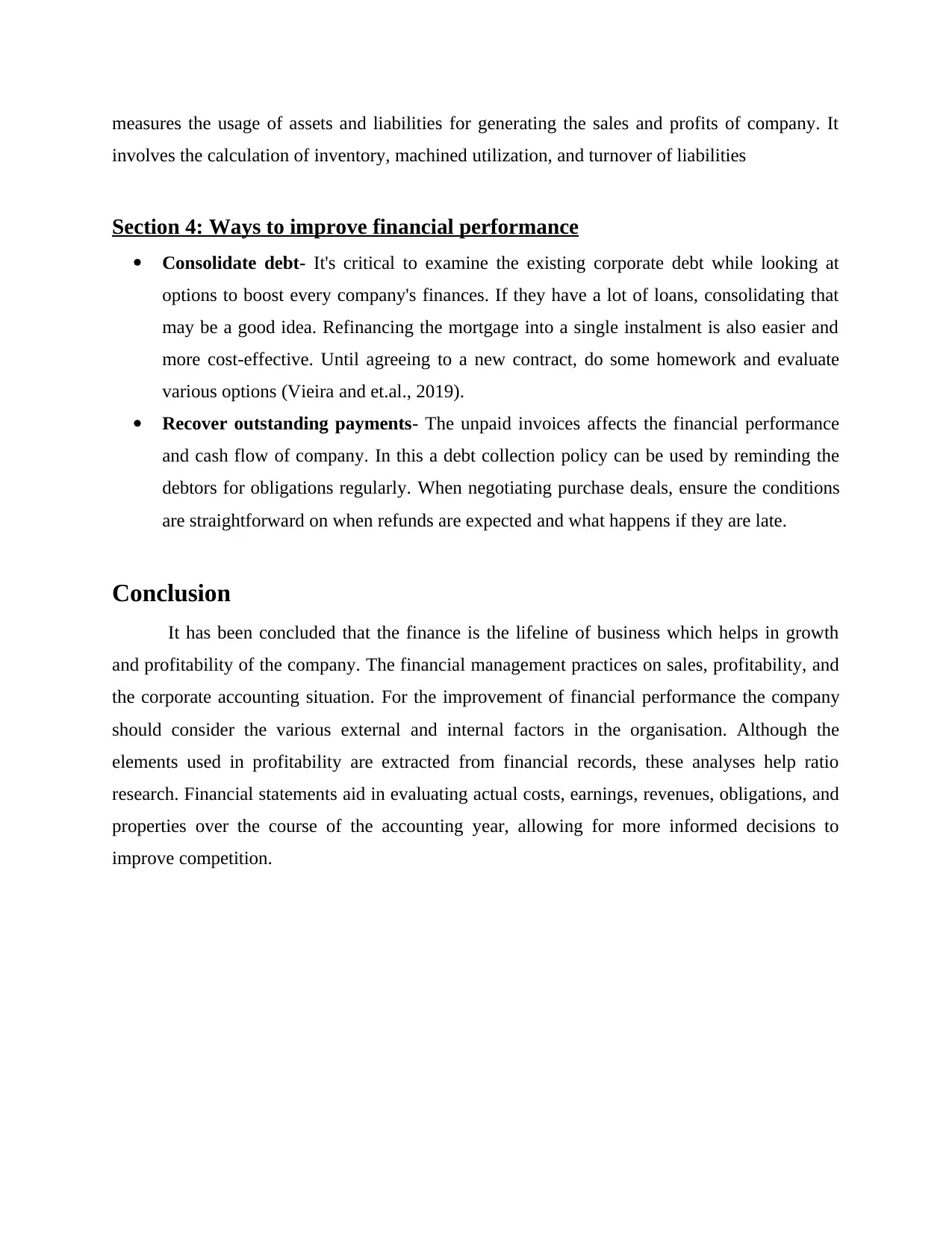
measures the usage of assets and liabilities for generating the sales and profits of company. It
involves the calculation of inventory, machined utilization, and turnover of liabilities
Section 4: Ways to improve financial performance
Consolidate debt- It's critical to examine the existing corporate debt while looking at
options to boost every company's finances. If they have a lot of loans, consolidating that
may be a good idea. Refinancing the mortgage into a single instalment is also easier and
more cost-effective. Until agreeing to a new contract, do some homework and evaluate
various options (Vieira and et.al., 2019).
Recover outstanding payments- The unpaid invoices affects the financial performance
and cash flow of company. In this a debt collection policy can be used by reminding the
debtors for obligations regularly. When negotiating purchase deals, ensure the conditions
are straightforward on when refunds are expected and what happens if they are late.
Conclusion
It has been concluded that the finance is the lifeline of business which helps in growth
and profitability of the company. The financial management practices on sales, profitability, and
the corporate accounting situation. For the improvement of financial performance the company
should consider the various external and internal factors in the organisation. Although the
elements used in profitability are extracted from financial records, these analyses help ratio
research. Financial statements aid in evaluating actual costs, earnings, revenues, obligations, and
properties over the course of the accounting year, allowing for more informed decisions to
improve competition.
involves the calculation of inventory, machined utilization, and turnover of liabilities
Section 4: Ways to improve financial performance
Consolidate debt- It's critical to examine the existing corporate debt while looking at
options to boost every company's finances. If they have a lot of loans, consolidating that
may be a good idea. Refinancing the mortgage into a single instalment is also easier and
more cost-effective. Until agreeing to a new contract, do some homework and evaluate
various options (Vieira and et.al., 2019).
Recover outstanding payments- The unpaid invoices affects the financial performance
and cash flow of company. In this a debt collection policy can be used by reminding the
debtors for obligations regularly. When negotiating purchase deals, ensure the conditions
are straightforward on when refunds are expected and what happens if they are late.
Conclusion
It has been concluded that the finance is the lifeline of business which helps in growth
and profitability of the company. The financial management practices on sales, profitability, and
the corporate accounting situation. For the improvement of financial performance the company
should consider the various external and internal factors in the organisation. Although the
elements used in profitability are extracted from financial records, these analyses help ratio
research. Financial statements aid in evaluating actual costs, earnings, revenues, obligations, and
properties over the course of the accounting year, allowing for more informed decisions to
improve competition.
⊘ This is a preview!⊘
Do you want full access?
Subscribe today to unlock all pages.

Trusted by 1+ million students worldwide
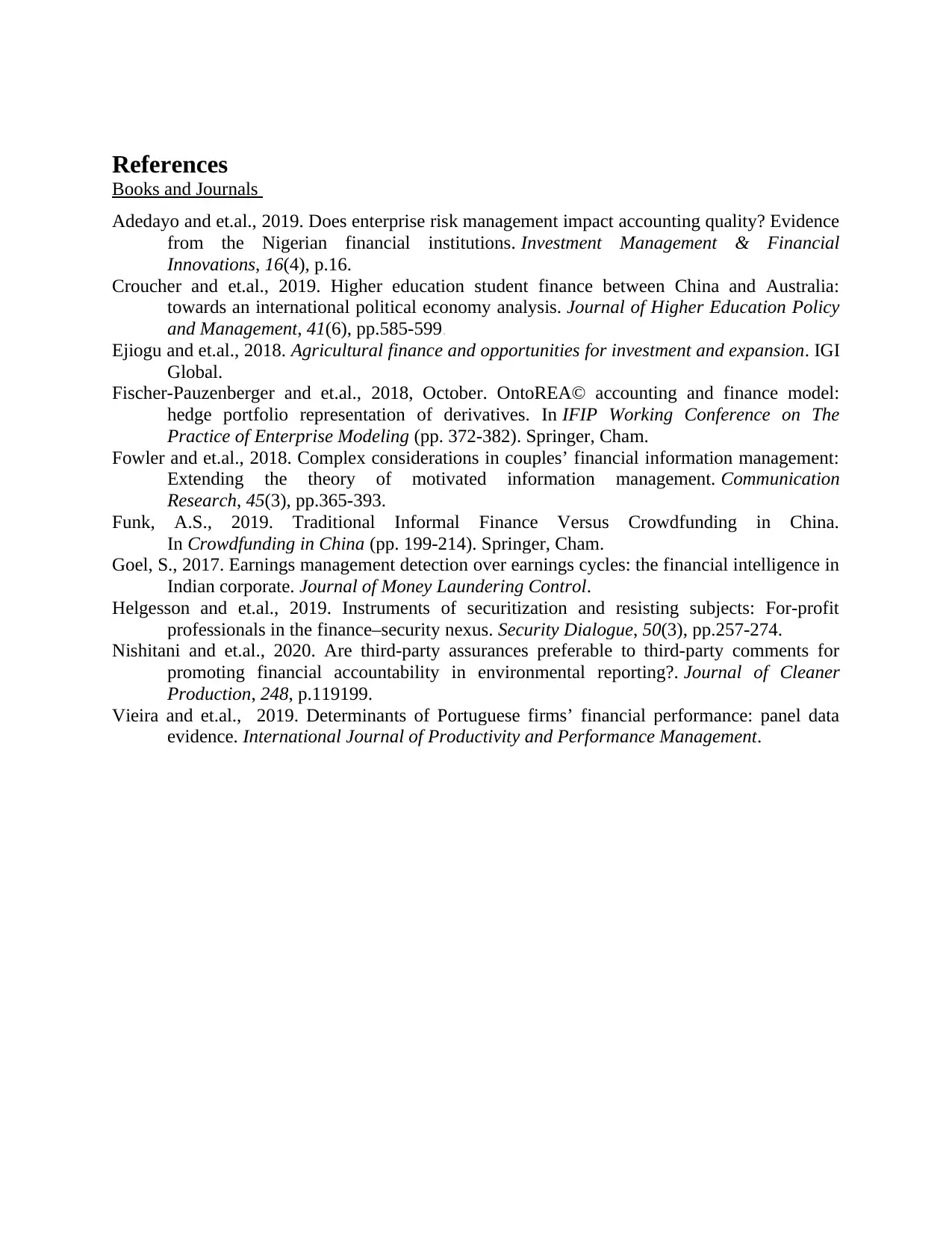
References
Books and Journals
Adedayo and et.al., 2019. Does enterprise risk management impact accounting quality? Evidence
from the Nigerian financial institutions. Investment Management & Financial
Innovations, 16(4), p.16.
Croucher and et.al., 2019. Higher education student finance between China and Australia:
towards an international political economy analysis. Journal of Higher Education Policy
and Management, 41(6), pp.585-599.
Ejiogu and et.al., 2018. Agricultural finance and opportunities for investment and expansion. IGI
Global.
Fischer-Pauzenberger and et.al., 2018, October. OntoREA© accounting and finance model:
hedge portfolio representation of derivatives. In IFIP Working Conference on The
Practice of Enterprise Modeling (pp. 372-382). Springer, Cham.
Fowler and et.al., 2018. Complex considerations in couples’ financial information management:
Extending the theory of motivated information management. Communication
Research, 45(3), pp.365-393.
Funk, A.S., 2019. Traditional Informal Finance Versus Crowdfunding in China.
In Crowdfunding in China (pp. 199-214). Springer, Cham.
Goel, S., 2017. Earnings management detection over earnings cycles: the financial intelligence in
Indian corporate. Journal of Money Laundering Control.
Helgesson and et.al., 2019. Instruments of securitization and resisting subjects: For-profit
professionals in the finance–security nexus. Security Dialogue, 50(3), pp.257-274.
Nishitani and et.al., 2020. Are third-party assurances preferable to third-party comments for
promoting financial accountability in environmental reporting?. Journal of Cleaner
Production, 248, p.119199.
Vieira and et.al., 2019. Determinants of Portuguese firms’ financial performance: panel data
evidence. International Journal of Productivity and Performance Management.
Books and Journals
Adedayo and et.al., 2019. Does enterprise risk management impact accounting quality? Evidence
from the Nigerian financial institutions. Investment Management & Financial
Innovations, 16(4), p.16.
Croucher and et.al., 2019. Higher education student finance between China and Australia:
towards an international political economy analysis. Journal of Higher Education Policy
and Management, 41(6), pp.585-599.
Ejiogu and et.al., 2018. Agricultural finance and opportunities for investment and expansion. IGI
Global.
Fischer-Pauzenberger and et.al., 2018, October. OntoREA© accounting and finance model:
hedge portfolio representation of derivatives. In IFIP Working Conference on The
Practice of Enterprise Modeling (pp. 372-382). Springer, Cham.
Fowler and et.al., 2018. Complex considerations in couples’ financial information management:
Extending the theory of motivated information management. Communication
Research, 45(3), pp.365-393.
Funk, A.S., 2019. Traditional Informal Finance Versus Crowdfunding in China.
In Crowdfunding in China (pp. 199-214). Springer, Cham.
Goel, S., 2017. Earnings management detection over earnings cycles: the financial intelligence in
Indian corporate. Journal of Money Laundering Control.
Helgesson and et.al., 2019. Instruments of securitization and resisting subjects: For-profit
professionals in the finance–security nexus. Security Dialogue, 50(3), pp.257-274.
Nishitani and et.al., 2020. Are third-party assurances preferable to third-party comments for
promoting financial accountability in environmental reporting?. Journal of Cleaner
Production, 248, p.119199.
Vieira and et.al., 2019. Determinants of Portuguese firms’ financial performance: panel data
evidence. International Journal of Productivity and Performance Management.
1 out of 10
Related Documents
Your All-in-One AI-Powered Toolkit for Academic Success.
+13062052269
info@desklib.com
Available 24*7 on WhatsApp / Email
![[object Object]](/_next/static/media/star-bottom.7253800d.svg)
Unlock your academic potential
Copyright © 2020–2025 A2Z Services. All Rights Reserved. Developed and managed by ZUCOL.




